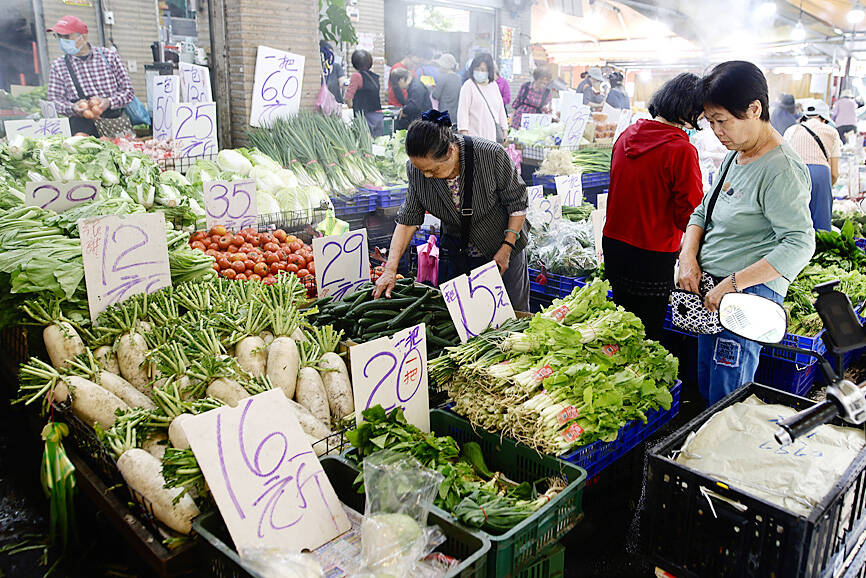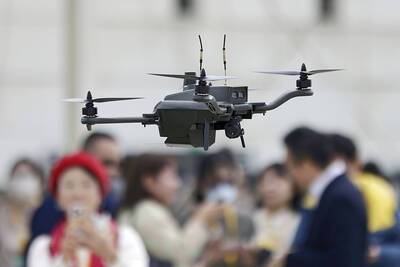The National Stabilization Fund (NSF) yesterday announced that it would step in to staunch stock market losses for the ninth time in the nation’s history.
An NSF board meeting, originally scheduled for Monday next week, was moved to yesterday after stocks plummeted in the wake of US President Donald Trump’s announcement of 32 percent tariffs on Taiwan on Wednesday last week.
Board members voted to support the stock market with the NT$500 billion (US$15.15 billion) fund, with injections of funds to begin as soon as today.

Photo: Ritchie B. Tongo, EPA-EFE
The NSF in 2000 injected NT$120 billion to stabilize stocks, the most ever. The lowest amount it has injected was NT$760 million over 201 days in 2020.
At the legislature yesterday, lawmakers scheduled for Premier Cho Jung-tai (卓榮泰) to present a report on Friday on government measures to support businesses hit hard by the US tariffs.
The government plans to spend NT$70 billion on measures such as lowering loan interest rates, reducing administrative costs and expanding tax exemptions for the affected industries.
It would also be used to help enterprises diversify their markets, and invest in research and development, the Executive Yuan said.
Another NT$18 billion would be allocated to support the agricultural sector through loans, interest subsidies, equipment subsidies and other measures.
Speaking ahead of a meeting at the legislature, Minister of Foreign Affairs Lin Chia-lung (林佳龍) said that Taiwan would negotiate with the US at any time on the tariff issue.
Taiwan was singled out by Washington as among the US trading partners with the highest surpluses.
President William Lai (賴清德) on Sunday proposed a zero-tariffs regime with the US, and to invest more in the nation and remove trade barriers.
Lin yesterday said that Taiwan was ready to talk about a variety of issues with the US, including investment in and purchases from the US, as well as non-tariff barriers.
“As long as there is a confirmed time and method for negotiations, they can be discussed at any time,” he said.
White House economic adviser Kevin Hassett on Monday said that Taiwan had reached out to discuss the tariffs and Cho yesterday confirmed that Taiwan was one of those seeking talks and the government would choose an appropriate time to present Lai’s plans to the US.
“We definitely have a comprehensive plan, we have the right people, and we will be able to go and have positive negotiations,” he said.
The TAIEX, which logged its worst fall ever on Monday, fell another 4.02 percent yesterday and hit its lowest level in 14 months.
Although Monday’s drop was significant, the government was adequately prepared, Cho said.
The Executive Yuan, the Financial Supervisory Commission and the central bank have conducted extensive analysis of various scenarios, he said.
Cho also thanked the commission and the Taiwan Stock Exchange for announcing temporary response measures on Sunday to help maintain stock market stability.
Public response has indicated that the measures were helpful and deterred short selling, he said.
The American Chamber of Commerce in Taiwan in a statement yesterday expressed its concern about the tariffs, and called on Washington to exempt Taiwan from trade actions that could “jeopardize the stability and trust underpinning the US-Taiwan relationship.”
Additional reporting by Cho Yi-chun

The combined effect of the monsoon, the outer rim of Typhoon Fengshen and a low-pressure system is expected to bring significant rainfall this week to various parts of the nation, the Central Weather Administration (CWA) said. The heaviest rain is expected to occur today and tomorrow, with torrential rain expected in Keelung’s north coast, Yilan and the mountainous regions of Taipei and New Taipei City, the CWA said. Rivers could rise rapidly, and residents should stay away from riverbanks and avoid going to the mountains or engaging in water activities, it said. Scattered showers are expected today in central and

COOPERATION: Taiwan is aligning closely with US strategic objectives on various matters, including China’s rare earths restrictions, the Ministry of Foreign Affairs said Taiwan could deal with China’s tightened export controls on rare earth metals by turning to “urban mining,” a researcher said yesterday. Rare earth metals, which are used in semiconductors and other electronic components, could be recovered from industrial or electronic waste to reduce reliance on imports, National Cheng Kung University Department of Resources Engineering professor Lee Cheng-han (李政翰) said. Despite their name, rare earth elements are not actually rare — their abundance in the Earth’s crust is relatively high, but they are dispersed, making extraction and refining energy-intensive and environmentally damaging, he said, adding that many countries have opted to

SUPPLY CHAIN: Taiwan’s advantages in the drone industry include rapid production capacity that is independent of Chinese-made parts, the economic ministry said The Executive Yuan yesterday approved plans to invest NT$44.2 billion (US$1.44 billion) into domestic production of uncrewed aerial vehicles over the next six years, bringing Taiwan’s output value to more than NT$40 billion by 2030 and making the nation Asia’s democratic hub for the drone supply chain. The proposed budget has NT$33.8 billion in new allocations and NT$10.43 billion in existing funds, the Ministry of Economic Affairs said. Under the new development program, the public sector would purchase nearly 100,000 drones, of which 50,898 would be for civil and government use, while 48,750 would be for national defense, it said. The Ministry of

UNITED: The other candidates congratulated Cheng on her win, saying they hoped the new chair could bring the party to victory in the elections next year and in 2028 Former Chinese Nationalist Party (KMT) lawmaker Cheng Li-wun (鄭麗文) yesterday won the party’s chair election with 65,122 votes, or 50.15 percent of the votes. It was the first time Cheng, 55, ran for the top KMT post, and she is the second woman to hold the post of chair, following Hung Hsiu-chu (洪秀柱), who served from 2016 to 2017. Cheng is to succeed incumbent Eric Chu (朱立倫) on Nov. 1 for a four-year term. Cheng said she has spoken with the other five candidates and pledged to maintain party unity, adding that the party would aim to win the elections next year and